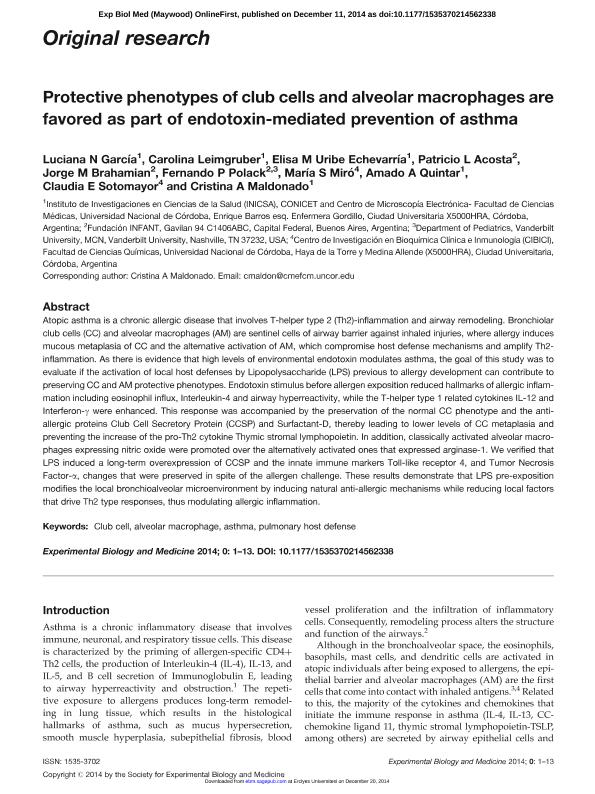Artículo
Protective phenotypes of club cells and alveolar macrophages are favored as part of endotoxin-mediated prevention of asthma
García, Luciana Noemí ; Leimgruber, Carolina
; Leimgruber, Carolina ; Uribe Echevarría, E. M.; Acosta, Patricio Leandro
; Uribe Echevarría, E. M.; Acosta, Patricio Leandro ; Brahamian, Jorge M.; Polack, Fernando P.; Miró, María Soledad
; Brahamian, Jorge M.; Polack, Fernando P.; Miró, María Soledad ; Quintar, Amado Alfredo
; Quintar, Amado Alfredo ; Sotomayor, Claudia Elena
; Sotomayor, Claudia Elena ; Maldonado, Cristina Alicia
; Maldonado, Cristina Alicia
 ; Leimgruber, Carolina
; Leimgruber, Carolina ; Uribe Echevarría, E. M.; Acosta, Patricio Leandro
; Uribe Echevarría, E. M.; Acosta, Patricio Leandro ; Brahamian, Jorge M.; Polack, Fernando P.; Miró, María Soledad
; Brahamian, Jorge M.; Polack, Fernando P.; Miró, María Soledad ; Quintar, Amado Alfredo
; Quintar, Amado Alfredo ; Sotomayor, Claudia Elena
; Sotomayor, Claudia Elena ; Maldonado, Cristina Alicia
; Maldonado, Cristina Alicia
Fecha de publicación:
12/2014
Editorial:
Soc Experimental Biology Medicine
Revista:
Experimental Biology And Medicine
ISSN:
1535-3702
Idioma:
Inglés
Tipo de recurso:
Artículo publicado
Clasificación temática:
Resumen
Atopic asthma is a chronic allergic disease that involves T-helper type 2 (Th2)-inflammation and airway remodeling. Bronchiolar club cells (CC) and alveolar macrophages (AM) are sentinel cells of airway barrier against inhaled injuries, where allergy induces mucous metaplasia of CC and the alternative activation of AM, which compromise host defense mechanisms and amplify Th2-inflammation. As there is evidence that high levels of environmental endotoxin modulates asthma, the goal of this study was to evaluate if the activation of local host defenses by Lipopolysaccharide (LPS) previous to allergy development can contribute to preserving CC and AM protective phenotypes. Endotoxin stimulus before allergen exposition reduced hallmarks of allergic inflammation including eosinophil influx, Interleukin-4 and airway hyperreactivity, while the T-helper type 1 related cytokines IL-12 and Interferon-γ were enhanced. This response was accompanied by the preservation of the normal CC phenotype and the anti-allergic proteins Club Cell Secretory Protein (CCSP) and Surfactant-D, thereby leading to lower levels of CC metaplasia and preventing the increase of the pro-Th2 cytokine Thymic stromal lymphopoietin. In addition, classically activated alveolar macrophages expressing nitric oxide were promoted over the alternatively activated ones that expressed arginase-1. We verified that LPS induced a long-term overexpression of CCSP and the innate immune markers Toll-like receptor 4, and Tumor Necrosis Factor-α, changes that were preserved in spite of the allergen challenge. These results demonstrate that LPS pre-exposition modifies the local bronchioalveolar microenvironment by inducing natural anti-allergic mechanisms while reducing local factors that drive Th2 type responses, thus modulating allergic inflammation.
Palabras clave:
Club Cells
,
Alveolar Macrophage
,
Asthma
,
Pulmonary Hosts Defense
Archivos asociados
Licencia
Identificadores
Colecciones
Articulos(CIBICI)
Articulos de CENTRO DE INV.EN BIOQUI.CLINICA E INMUNOLOGIA
Articulos de CENTRO DE INV.EN BIOQUI.CLINICA E INMUNOLOGIA
Articulos(INICSA)
Articulos de INSTITUTO DE INVESTIGACIONES EN CIENCIAS DE LA SALUD
Articulos de INSTITUTO DE INVESTIGACIONES EN CIENCIAS DE LA SALUD
Articulos(SEDE CENTRAL)
Articulos de SEDE CENTRAL
Articulos de SEDE CENTRAL
Citación
García, Luciana Noemí; Leimgruber, Carolina; Uribe Echevarría, E. M.; Acosta, Patricio Leandro; Brahamian, Jorge M.; et al.; Protective phenotypes of club cells and alveolar macrophages are favored as part of endotoxin-mediated prevention of asthma; Soc Experimental Biology Medicine; Experimental Biology And Medicine; 240; 7; 12-2014; 904-916
Compartir
Altmétricas



